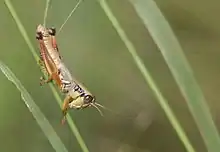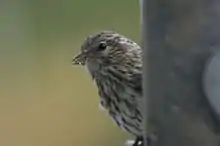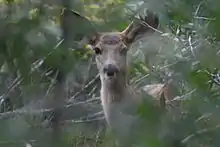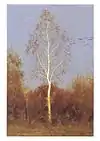Zoopoetics
Zoopoetics has been defined as "the process of discovering innovative breakthroughs in form through an attentiveness to another species' bodily poiesis." It assumes many actual, biological animals possess agency to craft gestures, vocalizations—clear material signs—in order to create social cohesion with conspecifics and other animals.[1]

Zoopoetics is not a minor event in poetry, nor is it limited to human spheres. Other species discover innovative forms of their bodily poiesis, through, at times, an attentiveness towards humans. Many disciplines have contributed to the radical revaluation of the animal in culture and society; zoopoetics further contributes through tracing the implications of Whitman’s insight, that animals, including humans, follow the “same old law” of a bodily poiesis.[2][3]
Usage
Jacques Derrida first used the term in The Animal that Therefore I Am (an address first delivered in 1997), speaking of “Kafka’s vast zoopoetics.”[4] And so, in the broadest sense, zoopoetics suggests the presence of nonhuman animals within a text. In a 2008 dissertation, Christopher White establishes another facet of zoopoetics by conflating it with the term zoosemiotics (the sign-systems of nonhuman animals), and he uses both terms to explore the presence and sign-systems of animals in William Faulkner’s As I Lay Dying.[5]
Another facet of zoopoetics is explored in “Zoopoetics: A Look at Cummings, Merwin, & the Expanding Field of Ecocriticism.” Here, zoopoetics is more of an approach that “gravitates to the agency of nonhuman animals” within both the ecosphere and within texts. The notion of animal agency is defined by how nonhuman animals are imaginative, rhetorical, and cultural beings.[6] The essay draws upon the well-known rhetorician George Kennedy, who published a controversial article in 1992: “A Hoot in the Dark: The Evolution of General Rhetoric.” In it, Kennedy argues that all animals, human and nonhuman, “share a ‘deep’ universal rhetoric.”[7] This rhetoric is not founded on sign-systems but rather upon what he calls the “rhetorical energy” of the gestures that deliver those sign-systems. Animals (including humans) constantly navigate rhetorical situations by delivering gestures to an audience with a specific purpose. Kennedy’s article challenged one of the long-standing assumptions concerning the difference between humans and animals, for he sees language as less of a distinguishing mark of human exceptionality and more of a commonality given the evolutionary origin shared by many animals. (For a recapitulation of the history of the response to Kennedy's article, as well as a defense of the ideas within it, see Debra Hawhee's "Toward a Bestial Rhetoric."[8])
Aaron Moe's book Zoopoetics: Animals and the Making of Poetry explores the zoopoetic dynamic in the poetry of Whitman, Cummings, Merwin, Hillman as well as several other poets.
As with many literary terms, it is helpful to look at the term’s etymology. Zoopoetics, etymologically speaking, has to do with how animals (zoo) can be capable of creation, or of "making" (poesis). Zoopoetics is seen as the process by which animal rhetorics may contribute to the making and shaping of both a specific poem as well as the overall poetics of a given author.[9]
One premise underlying zoopoetics is the notion that humans are not the only beings who dwell (in Heideggerian sense) on the earth. Nonhuman animals do as well. Some human poetry hints at the dwelling of the animal, but for obvious reasons, such an endeavor is fraught with challenges. Jacques Derrida articulates this challenge most clearly through his term limitrophy:

- Limitrophy is therefore my subject. Not just because it will concern what sprouts or grows at the limit, around the limit, by maintaining the limit, but also what feeds the limit, generates it, raises it, and complicates it. Everything I'll say will consist, certainly not in effacing the limit, but in multiplying its figures, in complicating, thickening, delinearizing, folding, and dividing the line precisely by making it increase and multiply. . . . [The limit] has an abyss: The discussion is worth undertaking once it is a matter of determining the number, form, sense, or structure, the foliated consistency, of this abyssal limit, these edges, this plural and repeatedly folded frontier.[10]
The limit between the human and the animal becomes its own infinite terrain within the text, but Derrida seems to have overlooked one crucial aspect. It is not just the human who strives to venture into the abyss of the animal—reaching with language and with gestures—for animals also strive to venture into the abyss of the human through their gestures and the vocalizations embedded within those gestures. Stephanie Rowe demonstrates what this ebb and flow encounter may look like in a text. In her article, Rowe explores how the orangutang in Poe's story reaches into the abyss of the human, seeking to change the human space into a shared space. This occurs when the orangutang—a species whose culture is oft defined by grooming—takes on the human ritual of shaving. His gestures are misunderstood, of course, which has morbid consequences.[11]
Zoopoetics, then, is an ebb and flow of energy between the human and the nonhuman. The human reaches into the abyss of the animal, but acknowledges the animals reach as well. Perhaps zoopoetics can best be experienced in a poetics that allows the gestures and vocalizations of nonhuman animals to permeate human language, through iconicity, thereby creating a shared space.[6]
Animal texts

Within literary studies, there is a movement toward a multiculturalism that includes the social networks of nonhuman animals.[12] For this to happen, though, humans must take seriously the notion that animals enter into rhetorical situations, crafting their own texts, for audiences, with specific purposes. The last thirty years of studies in animal behavior[13] have, in part, influenced the proliferation of video documentary of animals crafting such texts. For instance, Planet Earth captures several humpback whales coordinating efforts to surround krill with bubbles from their blowholes. As the video unfolds, viewers hear and witness the text the humpback whales craft. One can then infer that such behavior is learned, socially passed on from one generation of humpback to another. One can further infer that a single humpback, or a group of humpbacks, collectively had an innovative breakthrough in using the bubbles as a tool. This innovation had to be communicated to other humpbacks, and when this happens, the humpback enters into a rhetorical situation, relying on the text of song and gesture to communicate.
Orca also craft texts. Ethologists have recognized that such texts help maintain group cohesion,[14] and they may therefore exemplify how animal texts sustain nonhuman animal cultures. For a live feeds of orca vocalizations (and archives of past recordings) from the Puget Sound, listen to this hydrophone.
A wide range of animals demonstrate similar crafting of texts, but to take this seriously, one must wrestle with the implications of how nonhuman animals enter rhetorical situations.
See also
References
- Moe, Aaron (2014). Zoopoetics: Animals and the Making of Poetry. Lanham: Lexington Books. pp. 10, 19–22. ISBN 978-0-7391-8662-6.
- Whitman, Walt (1982). Poetry and Prose. New York: The Library of America. p. 199.
- Moe, Aaron (2013). "Toward Zoopoetics: Rethinking Whitman's 'original energy'". Walt Whitman Quarterly Review. 31 (1): 1–17. doi:10.13008/0737-0679.2091.
- Derrida, Jacques (2007). Marie-Louise Mallet (ed.). The Animal that Therefore I Am. Translated by David Wills. New York: Fordham UP. p. 6.
- White, Christopher (2008). "Dissertation". Animals, Technology, and the Zoopoetics of American Modernism: 115.
- Moe, Aaron (2012). "Zoopoetics: Cummings, Merwin, & the Expanding Field of Ecocriticism". Humanimalia: A Journal of Human/Animal Interface Studies. 3 (2).
- Kennedy, George (1992). "A Hoot in the Dark: The Evolution of General Rhetoric". Philosophy and Rhetoric. 25 (1): 6.
- Hawhee, Debra (2011). "Toward a Bestial Rhetoric". Philosophy and Rhetoric. 44 (1): 81–87. doi:10.1353/par.2011.0007.
- Moe, Aaron. (2012, March 21). "Zoopoetics Revisited" (blog post)
- Derrida, Jacques (2008). Marie-Louise Mallet (ed.). The Animal that Therefore I Am. Translated by David Wills. New York: Fordham UP. pp. 29–30.
- Rowe, Stephanie. Sarah E. McFarland; Ryan Hediger (eds.). No Human Hand? The Ourang-Outang in Poe's 'The Murders in the Rue Morgue,' in Animals and Agency: An Interdisciplinary Exploration. Boston: Brill. pp. 107–128.
- Feder, Helena (2010). "Rethinking Multiculturalism: Theory and Nonhuman Cultures". Interdisciplinary Studies in Literature and Environment. 17 (4): 775–777.
- Laland, Kevin N. and Bennet G. Galef (2009). The Question of Animal Culture. Cambridge: Harvard UP.
- Sargeant, Brooke L. and Janet Mann (2009). "From Social Learning to Culture: Intrapopulation Variation in Bottlenose Dolphins". In Kevin N. Laland; Bennet G. Galef (eds.). The Question of Animal Culture. Cambridge: Harvard UP. p. 161.
